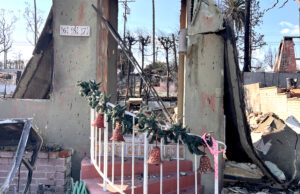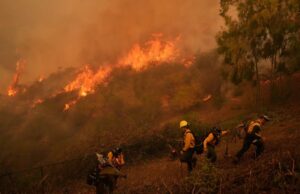Community unity stands strong in the face of wildfires

Fire threatens citizens’ safety
Nobody had expected what was going to happen on Nov. 8, 2018. Still reeling from the Borderline shooting that had happened the night before, Ventura County was not ready. The afternoon of Nov. 8, the Hill fire broke out, which burned 4,531 acres before it was fully contained. The fire started in the Santa Rosa Valley and spread very quickly, jumping the 101 freeway and burning part of the Vallecito trailer park homes. Soon after, the Woolsey fire started near Simi Valley and quickly spread throughout Ventura and Los Angeles before it was put out after burning 96,949 acres and destroying 1500 structures. When the structures are rebuilt, “the new homes will be designed and built to comply with newer State building codes that have greater fire prevention aspects,” Peter Gilli, deputy director of community development in Thousand Oaks, said.
Many students in the Newbury Park and Thousand Oaks area had to be evacuated due to the fires’ close proximity to their homes.
Deighan Valko, senior, lives in Santa Rosa Valley, close to where the Hill fire started. Valko is the owner of many animals that she had to bring to other houses when she was evacuated.
The main issue for Valko was her horse, who was in Newbury Park. “The smoke in Newbury was really bad, and it was bad for (the horse’s) lungs to be exposed to that… so we had to take them away, try to get the smoke away for a while,” Valko said. “It’s stressful to transport them… It can almost make them sick when they get super stressed like that.” However, the community came together and helped move horses to safer places. “The people who weren’t being evacuated were helping the people who were being evacuated,” Valko said.
Meagan Pruner, senior, lives behind the trailer park, where the fire got within 150 feet of her home. She first found out about the fire during fifth period. “At first it was just a cloud of smoke so I thought it wasn’t that big of a deal. But by the end of fifth period I could see the fire on the hill right by my house so I kind of panicked,” Pruner said.
When Pruner saw her house for the first time after the fire, she was surprised at how close the fire had gotten. “It was kind of crazy. I don’t know how else to say it. We knew it got close but we didn’t know (it was) that close,” Pruner said. “Everything was super smoky. I left my window open so everything was covered in soot.”
Unfortunately, others were not as lucky. The aftermath of the fires has left many people without their homes. One of these people is Nicholas Guerin, career education coordinator who had lived in the Seminole Springs mobile home park for five and a half years.
After evacuating early Friday morning, the day after the Woolsey fire started, Guerin found out that his home had burned down. “It was gut wrenching, it was a punch to the stomach, because that’s your home, it’s part of your identity. It feels almost like you lost a loved one,” Guerin said. “It’s not just about the building or the furniture, it’s about everything you created there, in that place, in that space, and that time you spent with your family and all of the experiences you had and all of the love are all, in a instant, gone.”
“You are never prepared for this type of an event 100%, but I can say that we knew that we were in a “high fire” area and we even paid an annual tax for wildfire protection. But my wife and I have done some preparation, especially observing how devastating the Thomas fires were last year, knowing that it could have been us,” Guerin said.
Despite knowing that this could happen, it was still hard to deal with it. However, Guerin did not have much time to grieve. His wife had just given birth to a third child, and they needed to find a place to stay. That was Saturday, Nov. 10. Two days later, Guerin found and rented a house in Oak Park.
“It was unbelievable… I was very emotional watching all of the news coverage of the Borderline tragedy and so I was already in an emotional state.” Guerin said.
After hearing about Guerin’s home, Steve Lepire, principal, and other teachers “put together a coordinated effort to ask if anyone had any items for donation or if anyone was able to provide any gift cards,” Guerin said. “So what happened was that we ending up taking an empty house into a fully functioning home in a record time. I think I was able to rent that house in Oak Park on Monday and by the end of the week the house was filled with furniture.”
The community support has helped Guerin and others throughout this whole ordeal. “What has helped with the uncertainty is the students, teachers and the people showing their support. It makes it feel like everything is going to be okay.”
School closures impact students and faculty
The entire school district of Conejo Valley made an impactful decision for school closures during the period in which the fires affected the surrounding communities. On Thursday, Nov. 8, the district released a notice that all CVUSD schools would be closed the next day. The district then decided to close all schools until after Thanksgiving break and resume on Nov. 26.
Although staff members in the district and on the NPHS campus had to adjust to the school closure, they felt it was the best idea to help rebuild the community. Steve Lepire, principal, enforced the executive decision of closing the CVUSD schools, in order to keep the students, faculty and district safe while assessing the outcome of school campuses post fire. Lepire also wanted to respect the physical and emotional damage the community was enduring.
“The difficult thing was determining the impact the fires had on our general community in terms of the amount of people that were evacuated and had not been able to get back in their homes, and the ability to assess the damages, what actual damage had taken place at specific schools,” Lepire said.
The school faced the challenge of adjusting the curriculum based on the days missed due to the fire. Teachers on campus were encouraged not to assign any work due the first day back, and to have resources available for students to review any missed material. Lepire acknowledged that block classes would be affected more than rotators, and students taking AP or IB level classes may miss a critical amount of information.
“We tried to make it very clear with teachers, and communicating with parents, that the goal is not to try to catch and make up everything that was missed in between that time period. We are going to look and see exactly what the essential things we want to get covered by the end of the term are,” Lepire said.
Although the fires have caused shifts in the curriculum, finals for students will remain the same, and will be taken the week of Jan. 14. “There was some conversation about moving the semester back a week, but the problem with that is we have that week blocked off, basically for no activities that week of finals. We build it around what we have,” Lepire said.
The NPHS community had concerns about making up the days missed, however, the CVUSD campuses will most likely not have to make up the days and have applied for a waiver based on natural disaster.
During the period in which the students were not at school, campuses were getting repaired and cleaned, in order for students to safely enter back into the school environment. Campus restoration workers dusted and cleaned every classroom from floor to ceiling. Each classroom had its air filters replaced to ensure a healthy air quality.
Lucia Lemieux, english teacher, had to make several changes in her curriculum for term one. Since Lemieux teaches block semester classes for 9th and 10th graders, the school closure has affected the timing of her assignments.
“Unfortunately there’s going to be a gap between what we finish before break and what we finish after. I’ll try to come up with some innovative ways to help refresh their memories when they come back but I’ve looked at the schedule there’s just no way I can do it,” Lemieux said.
Many teachers have to cram assignments in before the end of the semester in order to prepare each student for their IB tests in May. Debbie Dogancay, IB coordinator, has been planning the rest of her course accordingly.
“We’ve been working together by teams to figure out where we can distill concepts to the essence in order to focus on what’s on essential to prepare students for the exam. We’re not doing double time, we’re just cutting out non-essential pieces so that the students are just as well prepared for the exam, but taking into account that we lost days,” Dogancay said.
Businesses unite to support victims
Local businesses and corporations did not hesitate to reach out to the people of Thousand Oaks in a time of need. From donations for the firefighters to services for community members, the support received from businesses played a huge role in making TO a stronger community during this difficult time.
Five 07 is a coffee bar and eatery located in TO. On the Saturday after the fires started, Five 07 donated coffee to first responders and evacuees. Sean Mccarthy, the owner of Five 07, sent out an Instagram post looking for volunteers to deliver the coffee.
“We had 40 people respond within three hours, it was a beautiful, beautiful response,” Mccarthy said.
Mccarthy was recovering from the loss of a friend in the Borderline shooting while also having to worry about the safety of his home. Yet, during this difficult time he was able to connect with the community and wanted to do something to help.
“Living in the community, we saw we were part of all of the sorrow and the loss. Just trying to get through that made us realize how important community is. So for us it was important to open our shop to the people and try to raise some money,” Mccarthy said.
On the Saturday of the following week, Mccarthy had a few bands and singers come to the coffee bar for a memorial event. The next day, Mccarthy held a fundraising event, with performances given by bands and artists. Five 07 raised near a total of $3500 through album sales, food and drink, and cash donations. All the money raised was donated to the victim relief fund and wildfire relief fund under VCCF and RAK life where they help families recover from the fire.
With thousands of families needing to evacuate from their homes, finding a place to stay was a major concern for many people. Fortunately, several hotels in Southern California were providing free and discounted rooms to those who were under evacuation.
Adding to the disruption of the fires, many people experienced internet outages. To help, AT&T “waived charges to provide unlimited talk, text and data access for our customers.” AT&T customers were able to start using this benefit starting from November 9 to November 30. AT&T also donated $150,000 to communities affected by the fires in Northern and Southern California.
Also wanting to help the community, many businesses made donations and held benefits. Tavern 101 provided free meals for police, firefighters and first responders. The local Shake Shack in Westlake also provided free meals to police, firefighters and first responders for a week. In addition, they donated 100% of a day’s proceeds on November 13 to the Ventura County Community Foundation.
With a lack of time, many families had to leave their possessions behind. The Pallet in Westlake served as an emergency pop-up store that provided necessities to those evacuated from home. Kim Connelly-Cruz, the owner of the Pallet, wanted to help, and with the assistance of the community, she was able to start a clothing drive. Boxes of supplies were sent in from families and corporations.
“Today I just received three packages of leggings and sports bras; they just keep coming and they come from all walks of life but mostly from the community,” Connelly-Cruz said. “Everytime you looked around there was someone being generous or giving and it really shows how strong the community is.”
The store served as a pop-up store for eight days and is still continuing to make care packages.
While many businesses provided resources for people in need, there were also many others that wanted to help the animals. Kim Sill, the founder of Shelter Hope Pet Shop, provided shelter for evacuated animals in her shop at Janss Market.
“(People) had nowhere to go; they’d been driving around; they’d been turned away by a couple of other shelters and evacuation centers because they had the animals so I let them come into my shop,” Sill said.
The animal shelter filled quickly with people and their animals so Sill opened up another 4000 square feet of space from a vacant store. Within a couple of hours the shelter was filled with around 200 animals.
“We needed to be there for people. Because our name is Shelter Hope, when people were looking things up online, we appealed to them,” Sill said.
With the support from community members, businesses were able to gain all the resources needed to provide help for those in need.
“People would come in by the minute; every time we would post something people would show up with what we needed; it was quite miraculous– the generosity of the Thousand Oaks people in this horrific time,” Sill said.
Community comes together to help those in need
NPHS students were at the forefront of providing aid for those affected by the fires. Barely any time had passed after the fires broke out before students took the initiative to organize relief efforts for those in need.
Through her job at the Borchard Community Center, Alexis Rumsey, senior, was able to help evacuees, while experiencing the same situation first hand. Rumsey was home alone with her two sisters when they were ordered to evacuate.
“I just went to work, because I was scheduled to work anyways,” Rumsey said. “I worked at the evacuation center while I was being evacuated.”
As the fires spread, hundreds of families took shelter in the center. “The first night, Thursday night, we had over 400 families stay just in that center,” Rumsey said.
The Borchard Community center served as an evacuation center until Monday, Nov. 26. Cots and supplies were provided by the American Red Cross. Employees worked through the night to help evacuees.
“I know the first night I worked 12 hour shifts and it was crazy. I got to stay until 2 a.m.,” Rumsey said.
Despite the stressful situation, Rumsey was glad to help. “I love helping people, so it was worth it.”
Other students were quick to lend a hand. Maya Ghanem, senior, organized efforts to make care packages for firefighters after seeing the fires spread and reading about the reduced budget for fire relief. She learned about what was needed through lists on social media. Ghanem recruited 10 friends to help make the care packages through a social media post. The packages consisted of sunscreen, gold body powder, baby wipes, and food. Although there were some donations, Ghanem and her family bought most of the supplies themselves.
“We were fortunate enough to not have to be evacuated, so my family thought we should definitely do something,” Ghanem said.
With the help of her family and friends, Ghanem made around 40 care packages, which were donated to fire stations 30 and 34 in Thousand Oaks.
The NPHS boys soccer team also created care packages, receiving funds from the American Red Cross to make them.
“Inside each care package was a bottle of hand sanitizer, a tarp, gloves, building materials and first aid kit,” Randy Wright, senior, said.
The packages were delivered to Westlake and Malibu by certified truck drivers. The team made over 500 care packages for firefighters and victims of the fires. “It’s really just helping other people and making lives better,” Wright said.
When school resumed, counselors worked together to provide support for students.
While the counselors initially planned to offer resources for those affected by the events at Borderline, the fires led them to focus on creating a space for students to talk about any struggles they were experiencing.
“We wanted to support the students since we knew that many of them had been affected whether it was knowing a friend who was there, or knowing a friend who was going to go. Then, once the fires hit, our game plan was to create a supportive environment for those affected,” Napora said.
Counseling took place in the college and career center on Monday, Nov. 26. Five to ten counselors were available in the center throughout the day. Students had the option to talk in groups, or one on one with a psychologist.
“Some of our students benefited from this since they’d maybe never witnessed a tragedy so close to home; they could emotionally get support from our resources,” Napora said.
Others used the counseling as an opportunity to receive help with college applications. “Many of our students were coming to us more so because they were stressed about not being able to finish college applications on time due to the recent emotional trauma placed on them, so the counseling was good because it allowed them to kind of get closure and move forward,” Napora said.


